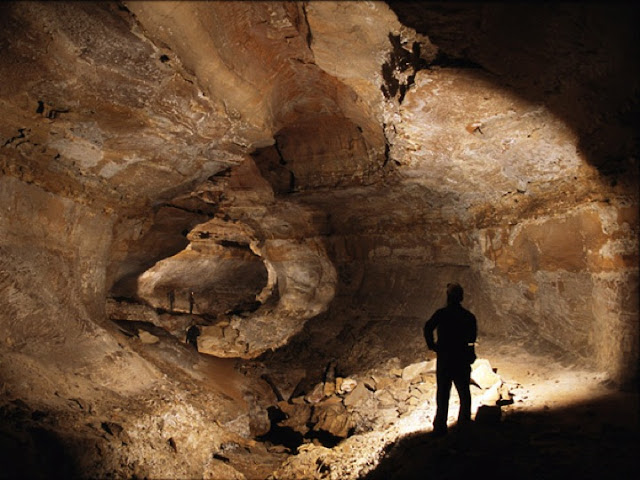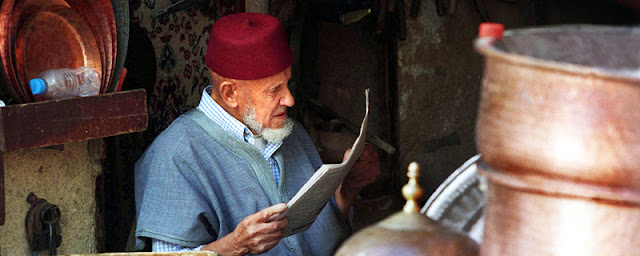Fez is the perfect place to base yourself for exploring the surrounding region. One fascinating getaway is to Jebel Tazzeka National Park, near the medieval city of Taza. There you can find an impressive underground cave network, the Friouato Caves. Suzanna Clarke reports on a day trip with a difference.
Setting out to visit the Friouato Caves in Jebel Tazzeka National Park, I had in mind a leisurely Sunday stroll. Perhaps a short walk down a few steps, then the chance to admire a long, well lit rock gallery. Naturally, the caves were nothing like this at all.
The Friouato caves (Arabic: مغارة فريواطو), better known by their French name Gouffre de Friouato, are located about 30 km south of the city of Taza. The farthest explored known point is about 272 meters, but its real limits are still mysterious. However, some locals believe that it is about 3.5 kilometres in length.
I and my two companions – Dr Gigi Kay, the director of the American Fondouk and her husband Dr Dick Hooper - found ourselves descending more than 100 meters into an enormous cave. This first chamber was lit through a hole at the top, through which trees and sky could be glimpsed. As we began our descent, we could only just make out people at the base of the climb. They looked to be the size of rabbits in a field. Initially there were hand rails, and then these petered out until it was a seemingly never-ending series of concrete steps - in reality there are more than 500.
The size of the cave seemed immense, and images from the Lord of the Rings movies sprang to mind. I could imagine the orcs scrabbling over rocks towards us. If not orcs, perhaps there is danger to be discovered in the depths of the cave system. People from the nearby village say many explorers have visited the cave, some of whom never returned.
When we reached the bottom of the first chamber, we followed the guide through a tiny crevasse in the rock, down another series of steps, to the interior of the cave. The sound of running water could be heard, and the chamber opened out to a limestone pool, constantly replenished by, a small waterfall. Clinging to the side wall were a couple of small bats, who ignored our torch beams.
We were grateful for our miners helmets and their lights, for the darkness was intense. We continued into another large chamber, which had a series of stalactites and stalagmites, formed by the deposition of calcium carbonate and other minerals. “It takes 100 years for a centimeter of stalactite to form, and even more for a stalagmite,” said our guide. According to my research, an average growth rate is actually 0.13 mm (0.0051 inches) a year. The quickest growing stalactites are those formed by fast-flowing water rich in calcium carbonate and carbon dioxide, these can grow at 3 mm (0.12 inches) per year.
We came to a limestone “table” on which there was a constant stream of water. Alongside it, the guide tapped a limestone stalagmite, which sounded hollow. When he shone his torch at the top of it, the length of it took on an eerie glow.
The multitude of sculptural shapes gave a magical feel to the cave. “You can imagine how they first thought of cathedrals,” said Dr Dick Hooper. I stood on the edge of a deep hole and could just see water at its base. More adventurous types than me have abseiled into its depths.
The Friouato Caves were first explored in 1930 by French adventurer Norbet Casteret. In 1969, a cave diving expedition by Exeter University Speleological Society passed two static sumps to discover more large chambers and shafts. The system ends in a massive choke of boulders. These may well be the same boulders that can be seen at the end of the upstream passages of the nearby Grotte du Chiker; this choke was also discovered in 1969 by the same group of cavers. There are also signs of an underground river that is believed to flow near the Grottes of Chiker.
We were offered the opportunity to continue into the depths for another three hours, to see yet more marvels, but declined and began our long ascent.
I have always thought myself claustrophobic, yet I was glad I had overcome whatever qualms I had had about being in a dark, enclosed spaces, to see an extraordinary natural phenomena.
Jebel Tazzeka National Park is located about 100 kms east of Fez, and can easily be reached via the new motorway which passes by Taza. Day trips can also be arranged with Plan-It Fez.
Size Matters
Tourism leads to wild claims about "the world's largest" "the world's deepest", "Africa's largest" and so on. Unfortunately these claims are picked up, republished on websites and get taken as fact. So to set the records straight...
While Africa has some impressive cave systems, it is well down any list of the world's largest or deepest caves. Africa's largest cave is (probably) Rhar Bou Ma'za (Tafna River Cave) in Algeria. It is 244th largest in the world at 18.4 kilometres.
Africa's 2nd largest cave (the 306th largest in the world) is said to be Sof Umar Cave in Ethiopia. It is formed by Web River, which rises from Bale Mountain. The 42 internal entrances and its total passages distance of 16 km. There is a short 1.7 kms tourist walk, which crosses the river seven times and takes about an hour.
None of the top ten largest caves in the world are in Africa.
 |
| The entrance to Mammoth Cave |
The cave system with the greatest total length of surveyed passage is Mammoth Cave (Kentucky, USA) at 628 km in length. This record is unlikely to be beaten in the near future, as the next most extensive known cave is Jewel Cave near Custer, South Dakota, at only 242 km.
The longest surveyed underwater cave is Sistema Sac Actun in Yucatán, Mexico at 215 km. The record has been exchanged several times with Sistema Ox Bel Ha, currently at 182 km.
The deepest known cave (measured from its highest entrance to its lowest point) is Voronya Cave in Georgia, with a depth of 2,191 m (7,188 ft). This was the first cave to be explored to a depth of more than 2 km (1.2 miles). The first cave to be descended below 1 km (0.62 mi) was the famous Gouffre Berger in France. The Illyuzia-Mezhonnogo-Snezhnaya cave in Georgia, (1,753 m or 5,751 ft) and the Lamprechtsofen Vogelschacht Weg Schacht in Austria (1,632 m or 5,354 ft) are the current second- and third-deepest caves, respectively. The deepest cave record has changed several times in recent years.
The deepest vertical shaft in a cave is 603 m (1,978 ft) in Vrtoglavica Cave in Slovenia. The second deepest is Patkov Gušt at 553 m (1,814 ft) in the Velebit mountain, Croatia.
The largest room ever discovered is the Sarawak Chamber, in the Gunung Mulu National Park (Miri, Sarawak, Borneo, Malaysia), a sloping, boulder strewn chamber with an area of approximately 700 by 400 m (2,297 by 1,312 ft) and a height of 80 m (260 ft). The nearby Clearwater Cave System is believed to be the world's largest cave by volume, with a calculated volume of 30,347,540 m3(1.071713×109 cu ft).
The largest passage ever discovered is in the Son Doong Cave in Phong Nha-Ke Bang National Park in Quang Binh Province, Vietnam. Explored by joint Vietnamese-British cave scientists of the British Cave Research Association, it is 4.6 km (2.9 mi) in length, 80 m (260 ft) high and wide over most of its length, but over 140 m (460 ft) high and wide for part of its length.
NOTE: It is interesting that a majority of explored caves occur in countries where caving is a popular sport. Many other countries probably have cave systems still to be explored. For example, China has massive limestone areas and it is expected those area will contain massive caves.
For more information on caves see the wonderful site run by "caverbob" - http://www.caverbob.com/
SHARE THIS!












.JPG)





























